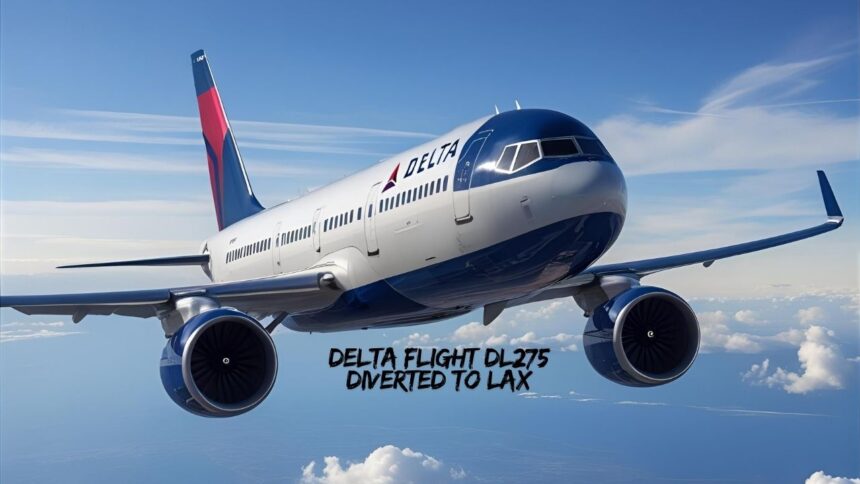Delta Flight DL275 Diverted to LAX: Full Details on What Happened, Why It Was Diverted, and Impact on Passengers
Flying is a convenient mode of transportation, but sometimes, unexpected events can occur during a flight, disrupting the travel plans of passengers. One such event took place recently with Delta Flight DL275, which was diverted to Los Angeles International Airport (LAX) during its journey from JFK (New York’s John F. Kennedy Airport) to Narita International Airport (Tokyo). This unexpected diversion raised a lot of questions among travelers, including why it happened, how it impacted passengers, and what steps the airline took to manage the situation.
This article delves into all the details surrounding the diversion, including the cause, the immediate impact on travelers, and what you need to know if you ever find yourself in a similar situation.
Overview of Delta Flight DL275
Delta Flight DL275 is a regularly scheduled, long-haul flight operating between JFK Airport in New York and Narita International Airport in Tokyo. It’s an important route for travelers flying between the United States and Japan, offering passengers a direct connection to one of Asia’s busiest airports. The flight operates as part of Delta’s international service, catering to both business and leisure travelers.
Typically, the flight travels over the Pacific Ocean, offering passengers a smooth journey, but in rare cases like this one, the flight can be subject to unforeseen changes that affect both the crew and the passengers.
The Reason for the Diversion of Delta Flight DL275
Flight diversions are rare, but they are an important safety measure in the aviation industry. The main reason for diverting a flight like Delta Flight DL275 is to ensure the safety of the passengers, crew, and the aircraft. In this specific case, Delta Flight DL275 was diverted to Los Angeles International Airport (LAX) due to a technical issue onboard.
Although Delta initially kept the exact details of the issue under wraps for privacy and safety concerns, it is common for diversions to be prompted by mechanical problems, onboard medical emergencies, or unexpected weather conditions. In this case, it was later confirmed that the flight diversion was made as a precautionary measure after the crew detected a technical warning in the aircraft’s system that needed immediate attention.
Aircraft are equipped with multiple systems that monitor performance during flights. If one of these systems alerts the crew about a potential problem, it is standard protocol to divert the plane to the nearest suitable airport for safety checks. LAX, being one of the largest and busiest airports in the United States, was the nearest major airport that could accommodate the flight’s emergency landing.
More EV News
How Did the Diversion Impact Passengers on Board?
The impact of a flight diversion is often a combination of inconvenience and uncertainty. Passengers on Delta Flight DL275, who were expecting a smooth journey to Tokyo, were suddenly faced with the need to adjust to a completely new set of circumstances. For many passengers, this disruption meant changing plans, missing connecting flights, or facing long delays.
Immediate Changes After the Diversion:
After the plane safely landed at LAX, the priority was ensuring the safety of everyone on board. Passengers were given updates about the situation and were informed that they would be rebooked on alternative flights to their final destination.
For some travelers, this meant rebooking on the next available flight to Tokyo, while others faced longer waits for further transportation arrangements. Delta’s crew guided the rebooking process, and airline staff at LAX worked quickly to accommodate passengers. Some were provided with hotel vouchers and meal allowances due to the length of the delay.
Passengers’ Missed Connections:
In cases of flight diversions, one of the major concerns for travelers is the possibility of missing connecting flights. Since Delta Flight DL275 was diverted to LAX, passengers with connecting flights at Narita or other destinations in Asia had to adjust their travel plans. This meant either rebooking flights to alternative destinations or waiting for the next available flight to complete their journey.
Delayed Arrivals and Compensation:
As a result of the diversion, the flight was significantly delayed. While Delta worked swiftly to address the issue and rebook affected passengers, those traveling on time-sensitive schedules experienced disruptions. Passengers may be eligible for compensation in the form of meal vouchers, hotel stays, or even flight credits, depending on the airline’s policies and the duration of the delay.
What Happens After a Flight Is Diverted?
When a flight is diverted, the airline immediately takes steps to address the needs of passengers. Here’s a breakdown of the steps that Delta would have followed in the aftermath of this diversion:
1. Ground Assessments and Safety Checks:
Once the flight lands at an alternate airport like LAX, the aircraft undergoes detailed safety checks by maintenance teams. These checks help ensure that the plane is airworthy and that the issue that prompted the diversion is resolved. The crew, alongside ground engineers, works to determine whether the aircraft can return to service or if it needs further repairs before it can fly again.
2. Passenger Rebooking and Support:
After the plane is grounded, airline staff immediately work on rebooking affected passengers on alternative flights. For those whose final destinations were Tokyo or nearby cities, Delta would have arranged rebooking on the next available flights. For those stranded at LAX, hotel accommodations and meal vouchers might be provided, especially if the delay was overnight.
3. Communication with Passengers:
During such a stressful event, communication is key. Delta kept passengers informed about the situation, explaining why the flight was diverted and what steps were being taken. Transparency in these situations helps passengers remain calm and prepared for the next steps.
4. Resumption of Service:
Once the technical issue is resolved and the plane is cleared for flight, the airline resumes its service, either continuing the flight to its original destination or arranging for a new aircraft to complete the journey. In the case of Delta Flight DL275, passengers were likely rebooked on another flight to continue their journey to Tokyo.
The Role of Safety in Airline Operations
The diversion of Delta Flight DL275 emphasizes the importance of safety in the airline industry. Diversions, though inconvenient, are an essential part of maintaining a high level of safety. Pilots, flight crews, and ground staff are trained to handle emergencies like these with the utmost care and professionalism. The priority is always to ensure that no further risks are posed to the passengers, the crew, or the aircraft.
Airlines like Delta are constantly monitoring their planes’ systems, and they follow strict protocols to ensure the safety of every flight. While passengers might feel frustrated at the disruption, the airline’s main goal is to prevent any serious safety issues, which can only be addressed by taking quick and decisive action, like diverting the flight.
How Common Are Flight Diversions?
Flight diversions may seem like rare events, but in reality, they happen more often than many travelers realize. According to the National Transportation Safety Board (NTSB), diversions occur for a variety of reasons, including medical emergencies, mechanical failures, and adverse weather conditions. However, the vast majority of diversions do not result in accidents or serious injuries.
Modern technology has made flight monitoring systems extremely reliable, but problems can still occur, which is why diversions are necessary. While they may be inconvenient for travelers, they are a crucial aspect of maintaining safety standards in aviation.
Conclusion
The diversion of Delta Flight DL275 to LAX was an unexpected but essential decision made to prioritize passenger safety. Though passengers experienced disruptions to their travel plans, the diversion was handled quickly and efficiently by the airline, with rebooking and support services provided to those affected. This event serves as a reminder that the airline industry’s first priority is always safety, and diversions are a vital part of ensuring that passengers arrive at their destinations safely.
(FAQs)
1. Why did Delta Flight DL275 get diverted to LAX?
Delta Flight DL275 was diverted to Los Angeles International Airport due to a technical issue detected during the flight. The diversion was a precautionary measure to ensure the safety of the passengers and crew.
2. What should I do if my flight is diverted?
If your flight is diverted, stay calm and listen for updates from the flight crew. Airlines usually provide assistance such as rebooking, meal vouchers, or hotel accommodations.
3. Are diversions a common occurrence in aviation?
Flight diversions do occur from time to time, but they are relatively rare. They happen for safety reasons, such as weather issues, mechanical failures, or medical emergencies.
4. How does a diversion affect my travel plans?
A flight diversion can delay your arrival and may cause you to miss connecting flights. However, airlines typically help rebook passengers and provide compensation where necessary.
5. Can I get compensation if my flight is diverted?
Yes, depending on the situation and the airline’s policies, you may be eligible for compensation, such as hotel stays, meal vouchers, or flight credits.
6. What happens to the plane after a diversion?
After a diversion, the aircraft undergoes safety checks to ensure it is fit for further travel. If the issue is resolved, the plane may continue to its original destination, or passengers may be rebooked on other flights.
By following the story of Delta Flight DL275’s diversion, travelers can better understand the aviation process and how airlines prioritize safety in unexpected situations. Flight DL275 diverted to LAX serves as a real-life example of how the industry ensures passenger well-being at all times, even during a diversion.





